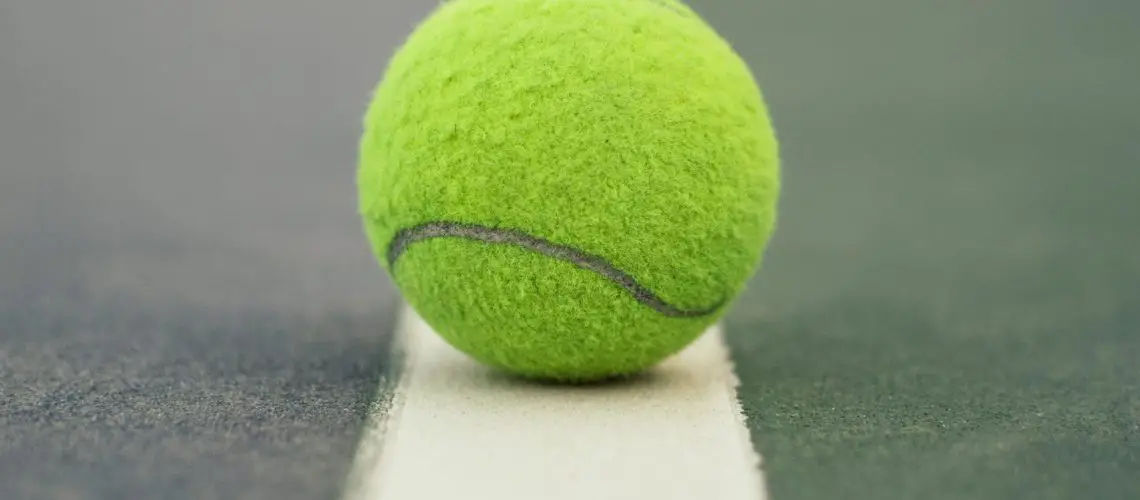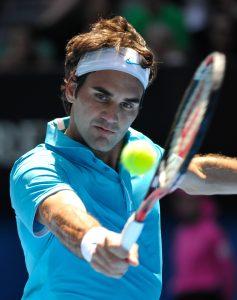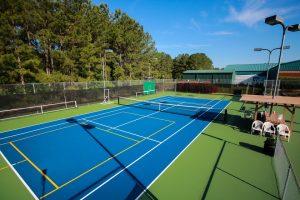We may earn money or products from the companies mentioned in this post.
Brief Overview of Tennis as a Sport

Tennis, a captivating sport that combines agility, precision, and strategy, has a rich history and immense popularity worldwide Originating in 19th-century England, it quickly spread across the globe, captivating players and spectators alike with its fast-paced action and competitive spirit
With its roots in real tennis and rackets, modern tennis evolved into the game we know today It gained prominence during the late 19th century when tournaments like Wimbledon were established Since then, tennis has become one of the most widely played sports globally
The basic rules of tennis are relatively simple yet offer endless possibilities for skillful play Players face off on opposite sides of a rectangular court divided by a net The objective is to hit the ball over the net using a racket and ensure it lands within the boundaries of their opponent’s side while avoiding hitting out or into the net
Matches consist of sets, which are further divided into games Points are scored within each game until one player reaches four points (known as “40”) with at least a two-point lead to win that game The first player to win six games with a two-game lead wins the set, while matches usually consist of three or five sets depending on tournament rules
Importance of Understanding the Baseline in Tennis

For Players and Coaches
The baseline is an essential element in every tennis match For players and coaches alike, understanding its significance can greatly impact gameplay strategies and overall performance
From the baseline position at the back end of each side of the court, players have numerous options for shot selection – they can hit powerful groundstrokes down-the-line or cross-court or opt for drop shots to catch opponents off-guard
By mastering baseline play, players can dictate the rhythm of a match, control the court’s geometry, and exploit their opponents’ weaknesses It allows for strategic shot placement and effective use of topspin or slice to create angles or force errors
Coaches play a vital role in helping players develop their baseline skills They analyze opponents’ play styles, devise game plans to neutralize strengths, and maximize opportunities from the baseline position A thorough understanding of baseline tactics enables coaches to provide valuable guidance on footwork, shot selection, and overall strategy
For Spectators and Enthusiasts
The baseline is not only crucial for players but also adds excitement for spectators and tennis enthusiasts watching matches From this vantage point, they witness powerful exchanges between players as they unleash thunderous groundstrokes with precision and finesse
Spectators get a front-row seat to observe how professional tennis players maneuver around the baseline – chasing down balls with lightning-fast speed, executing explosive winners from defensive positions, or displaying impressive defensive skills by returning seemingly impossible shots
Understanding the nuances of baseline play enhances appreciation for the sport’s technical aspects Spectators can marvel at players’ ability to hit accurate passing shots while on the run or admire their strategic use of angles to open up space on the court
Enthusiasts can study top-ranked players who excel from the baseline and incorporate these techniques into their own game Analyzing how professionals handle pressure situations can inspire amateurs to improve their shot selection and footwork when playing at local clubs or tournaments
Understanding the Baseline in Tennis
Tennis, a sport known for its fast-paced action and strategic gameplay, revolves around various elements that contribute to the overall dynamics of the game One such crucial element is the baseline, which plays a significant role in court dimensions and greatly impacts gameplay
Definition of the Baseline
The baseline in tennis refers to the line that runs parallel to the net at the back of each side of the court It divides the playing area into two halves and sets boundaries for both players during a match
This line serves an essential purpose in determining court dimensions, ensuring fair play, and providing guidelines for different shots and strategies employed by players
Characteristics of the Baseline
The baseline possesses specific characteristics that make it distinctive on different tennis courts Firstly, it has a defined width that spans from sideline to sideline across the full width of the court
In terms of length, it extends from one singles sideline to another singles sideline or doubles sideline if playing doubles This length varies depending on whether it’s a singles or doubles match
To clearly demarcate its position on the court, there are markings along its length These markings help players stay within bounds and make accurate judgments during gameplay
Furthermore, depending on the type of playing surface – be it clay, grass, or hardcourt – materials used for constructing baselines may differ slightly This ensures optimal performance and durability according to each surface’s unique characteristics
Key Elements Related to the Baseline
An important consideration when discussing baselines is distinguishing between singles sidelines and doubles sidelines In singles matches, players must hit their shots within these narrower lines compared to wider doubles sidelines used in doubles matches
Another essential factor related to the baseline is its relationship to the service box position The service boxes are located in front of each baseline, and depending on where the server stands within these boxes, different strategies and shot selections may come into play
Overall, understanding the baseline in tennis is crucial for players to navigate the court effectively and employ winning tactics It sets boundaries, defines court dimensions, and impacts gameplay significantly By mastering this fundamental aspect of tennis, players can enhance their performance and excel on the court
Tactics Used at The Baseline

In the game of tennis, the baseline is a crucial area where players strategically position themselves to gain an advantage Different tactics can be employed at the baseline, depending on the player’s style and the situation at hand
Baseline Playing Styles
When it comes to baseline playing styles, there are two main categories: aggressive baseliners and defensive baseliners Let’s take a closer look at the advantages and disadvantages of each:
Aggressive Baseliner: Advantages & Disadvantages
An aggressive baseliner is known for their powerful shots and relentless attacking mindset They aim to dominate rallies by hitting winners and putting pressure on their opponents This style can be advantageous as it allows players to dictate play, keeping their opponents on the back foot However, being overly aggressive can sometimes lead to unforced errors and inconsistency
Defensive Baseliner: Advantages & Disadvantages
On the other hand, a defensive baseliner focuses more on consistency, patience, and counterpunching They rely on retrieving balls with accuracy and waiting for opportunities to attack This style can frustrate opponents who prefer a faster pace of play and force them into making mistakes However, defensive baseliners may struggle to generate enough power in their shots to finish points quickly
Maneuvering Shots from The Baseline
Once players are positioned at the baseline, they need effective shot-making techniques to control rallies Some key aspects include:
Groundstrokes – Forehand and Backhand
The forehand and backhand groundstrokes are fundamental shots used from the baseline Players must master proper technique, footwork, and timing to generate power and accuracy These shots allow players to hit the ball with depth and control, keeping their opponents on their toes
Angles & Depth Control
Creating angles with shots is a vital strategy for baseliners By hitting cross-court or down-the-line shots with precision, players can force their opponents out of position and open up the court for winners Depth control is equally important, as it puts pressure on opponents by pushing them deeper into the court
Topspin vs Flat vs Slice Shots
Baseline players can choose from different shot types to vary their game Topspin shots are effective in generating bounce and creating heavy balls that jump off the court Flat shots are flatter and faster, making it harder for opponents to handle pace Slice shots have a lower trajectory and can be used strategically to change the rhythm of rallies
Changes in Tactics Based on Opponent’s Playstyle
To succeed at the baseline, players must adapt their tactics based on their opponent’s style of play If facing an aggressive baseliner, a defensive player may need to absorb pace and focus on consistency On the other hand, an aggressive player may need to mix up their game when playing against a strong counterpuncher
Understanding your opponent’s strengths and weaknesses allows you to adjust your shot selection, placement, and overall game plan accordingly Adapting tactically will increase your chances of overcoming different styles of play at the baseline
Baseline Drills & Training Techniques

When it comes to mastering the game of tennis, honing your skills from the baseline is essential The baseline is where many rallies begin and end, making it crucial to develop consistency and precision in your shots By integrating a variety of drills into your training routine, you can enhance your performance and take your game to new heights
Increasing consistency from the baseline
To become a formidable force from the baseline, cross-court drills are an effective way to improve your shot accuracy and control These drills involve hitting shots diagonally across the court, forcing you to maintain consistent depth and power in your strokes
Another valuable drill for increasing consistency is the down-the-line drill This exercise focuses on hitting shots straight down the line, improving both accuracy and placement By practicing these drills regularly, you’ll develop a reliable foundation for your baseline game
Improving footwork on the baseline
Footwork plays a vital role in executing successful shots from the baseline To enhance your agility and movement on court, shuffle step drills are highly beneficial These drills involve quick lateral movements along the baseline, mimicking real-game scenarios where you need to adjust quickly to hit different types of shots
In addition to shuffle step drills, incorporating split step exercises into your training routine can have a significant impact on your footwork technique The split step involves jumping slightly off both feet as soon as you anticipate that your opponent will make contact with the ball This helps you react swiftly and efficiently while maintaining balance during rallies
Developing anticipation skills near the baseline
Gaining an edge over opponents requires more than just technical proficiency; it also involves developing keen anticipation skills near the baseline Pattern recognition exercises are an effective way to enhance your ability to anticipate your opponent’s shots By studying common patterns and tendencies, you can position yourself strategically and be ready for their next move
Furthermore, scouting opponents can provide invaluable insights into their playing style, strengths, and weaknesses By analyzing their previous matches or observing them in action, you can tailor your training and strategies accordingly This knowledge will give you a competitive advantage when it comes to anticipating shots near the baseline
Incorporating these drills and training techniques into your practice sessions will undoubtedly elevate your baseline game Remember, consistency, footwork, and anticipation skills are key components of a successful tennis player So get out on the court and start improving your skills from the baseline!
Useful Links

Court Position in Baseline Play | CoachUp Nation
Baseline. Meaning in tennis. Definition. Wiki. Terms
Optimal Tennis Baseline Position And Movement
Ridder Arena/Baseline Tennis Center – UMN Campus Maps
Baseline Tennis Center (@baseline_tc) …
tennis-court-dimensions.pdf
What’s the point of playing behind the baseline in tennis?
Baseline Tennis
Baseline Tennis Center (@BaselineCenter …
Mission Transition: how to bring your game from baseline …
Baseline Tennis Tote
Baseline Sports Construction
Baseline: Tennis on the App Store
Baseline Tennis Dress – White






